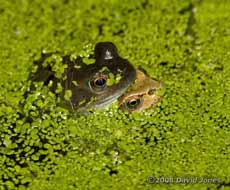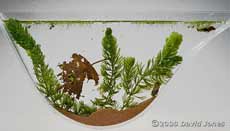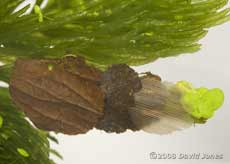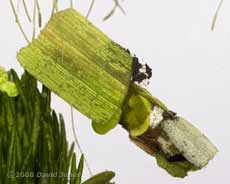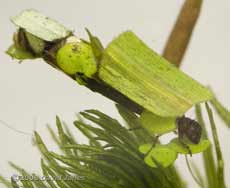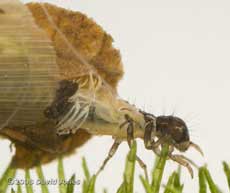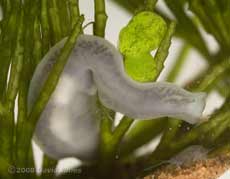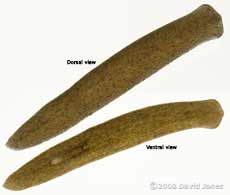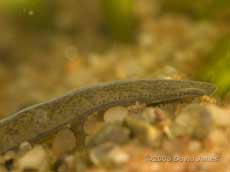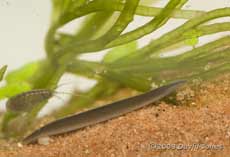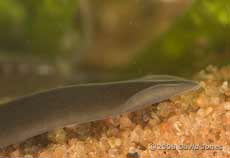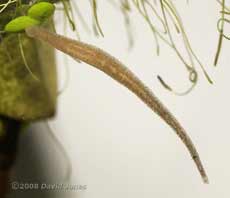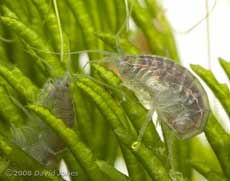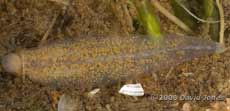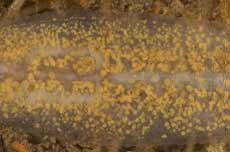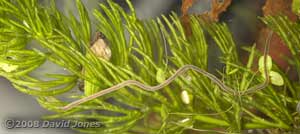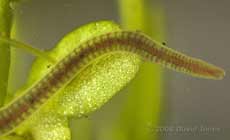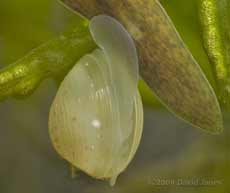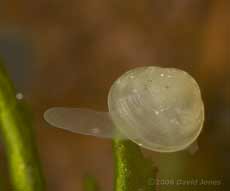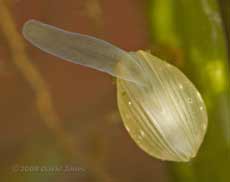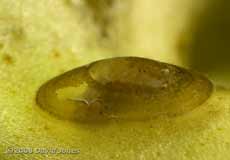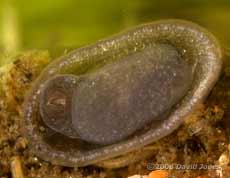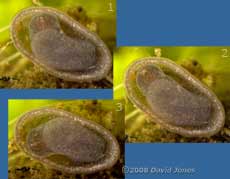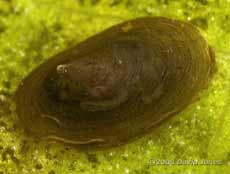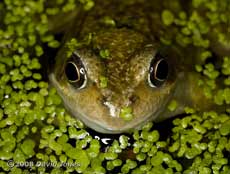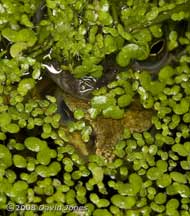Go to latest entry.
I have still to complete preparing the big pond ready for spawning. While spawning isn't likely to take place for several weeks yet (23 Feb last year, after a very cold spell), I need to get the job done very soon to minimise disruption nearer to the 'big day'.
20 January - A dry morning gave me the chance to finish clearing the shallow, spawning end of the pond, although I still need to do a bit more work in other areas of the big pond. During that work I saw one pair of frogs that were in a state of amplexus. I don't think it was the pair I photographed yesterday - the male was lighter, with dark blotches. I also came across a mature female Smooth Newt in the shallow area. This is the first newt I've seen since 27 November when I found two hunting amongst the leaf litter under the Birch tree (see Garden Diary entry for that day). With the present mild spell continuing (the temperature hardly dropping below 12C for the last 48 hours, and over 13C by noon today) it will be interesting to see how many frogs make an appearance tonight. A warning against a false start for the frogs - looking back at last year's diary, we were having similar conditions at this time, but within days the pond was frozen over and we had snow! There's no sign of that happening at the moment, but the current five day forecast suggests that it is going to get colder, with a night-time low of around 1C on the night of the 24th-25th. Tonight at 9.30pm I counted 25 frogs, including several pointy nosed immature individuals, one about the size of a thumb nail (smaller than yesterday's youngster). No more newts sighted tonight, but the water in the shallow area is still murky after my work this morning. During the pond clearing I was surprised by the number of caddis fly larvae I discovered amongst the floating pond weed. Before committing the weed to recycling I spent ages going through it to rescue the larvae and to check for newtlets - I haven't seen any of these so far this month, although I would expect to do so as the adult newts start appearing. I hope to take some photographs of the larvae tomorrow, along with an adult caddis fly that I came across.
21 January - No work done on the pond today but I did get round to taking some photographs.
The tank consists of two sheets of glass separated by a curved strip of perspex to create a tank which is approximately 280x130x17mm across.
At first glance, the caddis fly larvae that I found yesterday are completely camouflaged, hidden inside silk tubes which are decorated with pieces of leaf. This one is quite neat, with curved sections of leaf reminiscent of the pieces cut by leaf cutter bees.
In contrast, this one is made up of rather rectangular pieces (other than the duckweed leaves).
However, once you have spotted one of the clumps of leaf bits, it's soon obvious that there is something hidden underneath them The caddis fly larva emerges a short way out of the tube to move about using its three pairs of legs and to feed on the vegetation.
Occasionally, one will emerge a bit further to expose some of the gills that protrude form its abdominal segments. These extract oxygen from water passing through the tube. I have yet to identify the species.
There are several other animals in the tank, including two, or perhaps three species of flatworm.
The largest is this milky coloured Dendrocoelum lacteum which growths to around 25mm in length, although this one is still only around 12mm long.
The next is this somewhat mottled species with a large number of eye spots that extend a third of the way down each side of its body. The ventral (underside) view, the dark area towards the tail marks the position of the flatworm's pharynx and mouth - the only opening of its digestive tract. As well as taking in food here, it also ejects waste through it. I believe that the light spot just behind the pharynx marks the opening of the flatworm's reproductive system. Nearly all flatworms are hermaphrodites, having both male and female reproductive organs.
This shot shows the eye spots more clearly. I think this is Polycelis nigra, which despite its name can range in colour from white to black.
This third example seems much more uniform in colour with no sign of eye spots along its sides.
It's interesting to see how the sides of its broad head are raised, almost like fins, much more so than in P. nigra. I don't know what the species is.
This single leech found its way into the tank, probably on the plants.
The main swimmers in the tank are freshwater shrimps (Gammarus pulex) which when they are not grazing are swimming very quickly about on their sides, or upside-down. I must try to get a shot of one in motion.
23 January - No photographs taken or work done around the ponds today, but yesterday I completed the task of clearing the shallow end of the big pond. I didn't clear new Iris growth last year and this had blocked one of the channels between the deep and shallow areas of the pond. However, as of yesterday, the old cherry log once again stands on a island in the pond. Tonight, the frog count at 9pm is 25 - no increase since the 20th.
26 January - The frog arrivals seem to have halted for the moment. The night before last I didn't do any counting after I found a hedgehog wandering by the side of the big pond. Last night, with the air temperature around 7C at 10pm there was no hedgehog about and the frog head count came to just 12. Today, while logs were being chopped outside, I brought my mini-aquarium indoors for a short time to take a few more photographs. The cold tank gets covered with condensation. Even when this is wiped away it soon returns, but I don't want to let the water warm up (which of course would end the condensation problem!).
It may be Haemopsis sanguisuga - I need to get a close-up of the top of its head, showing if it has five pairs of eyes.
This picture shows an close-up of the central portion of its body. If you look closely then you will see the curved outlines of the sgments.
It measures over 7cm in length and the head is hidden in the foliage at the left in this photograph (which has been turned anticlockwise by 90 degrees).
Here is a closer look at what I think is the tail end, showing the segmented nature of the worm. If you click on the image you will also see closer images of two areas of its body.
Finally, some views of pea-shell cockles (Pisidium sp.). I often find examples up to 8mm across, but the examples in the tank are no more than a couple of millimetres across. This one's foot is being 'trodden on' by a passing flatworm.
n this second image you can see the cockle's single short siphon protruding from the lower right side of the shell.
Finally, this picture gives a different view of the foot protruding through the mantle.
These small creatures measure no more than 5mm in length and only 1-2mm tall. The front end of this individual is to the left in this photograph. I hope to get some better images of the shell.
Hidden under the shell, the limpet has a large foot which it uses to move around the vegetation. In this image its head is on the left, and its mouth is open. Look carefully below the head and you can make out one of its antennae. The limpet's mantle seems to be curved around the leading edge of the shell, but is pulled away from the rear edge. There seem to be many oily-looking droplets
in the mantle. They don't look like air bubbles, so what could they be?
This trio of images show it moving its head from side to side as it grazes on algae.
Last night at 9.30pm I counted 16 frogs but no newts in the ponds. Tonight at 10pm, with the air temperature down to below 4C I could see 17 frogs, with one pair in a gentle 'embrace'.
29 January - We should be getting some rain later this week which will be gratefully received by the ponds. The recent mild weather hasn't brought much rain and levels are dropping. Perhaps a bit of rain will also encourage hibernating frogs (and newts) to start their journeys to ponds - last night I counted 14 adults, with one pair linked together. However, I see that the five day forecast from the Met Office also suggests that we may have ice by the weekend!
Just one picture today. As promised, I took another picture of a Lake Limpet. In this shot you can see how the tip of the conical shell points towards the rear of the animal, and is more pronounced than on the previous example. This one is about 3.5mm long.
A late addition after I checked the ponds at 10pm - There was an increasing dampness in the air, the temperature was still around 9C and when I shone my torch at the ponds it was obvious that there were more frogs to be counted tonight. In fact, I counted 34, as well as a single newt.
As usual, that count is based on what I can see without disturbing the vegetation around the ponds, so it should be read as saying 'there are at least 34 frogs' in the ponds tonight. Most, like this one, are quite easy to spot, with their heads protruding from the duckweed cover.
However, it's not a good idea to scan the surface too quickly as it is too easy to miss pairs like this, with their snouts only just breaking the water's surface. Move the torch about too quickly and they just slip down into the darkness below the weed cover. In total I saw six pairs in amplexus.
31 January - During the late morning, heavy rain ensured that the ponds were fully topped up. Tonight at 9pm, the 5C air temperature feels colder as a result of a brisk north-north-westerly breeze (after wind speeds of up to 40mph earlier in the day). Not surprisingly, visible frog numbers are down, with just 14 counted. Click on images to see larger versions |
|
